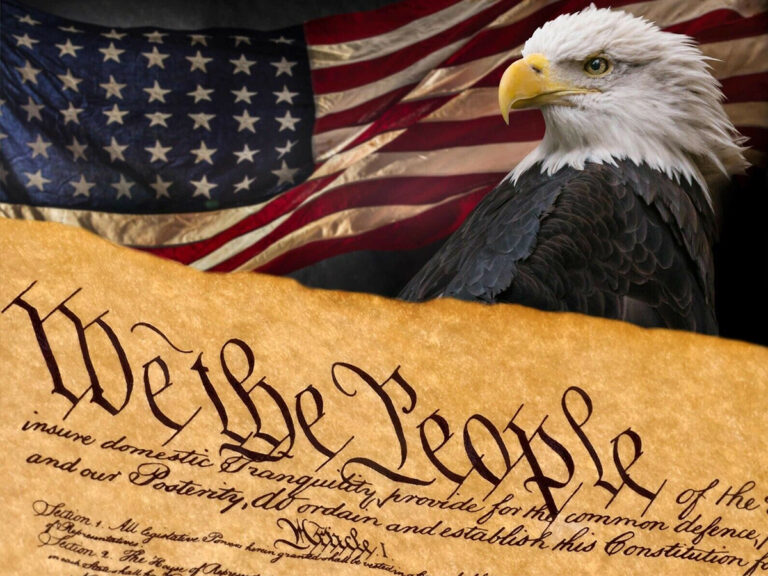
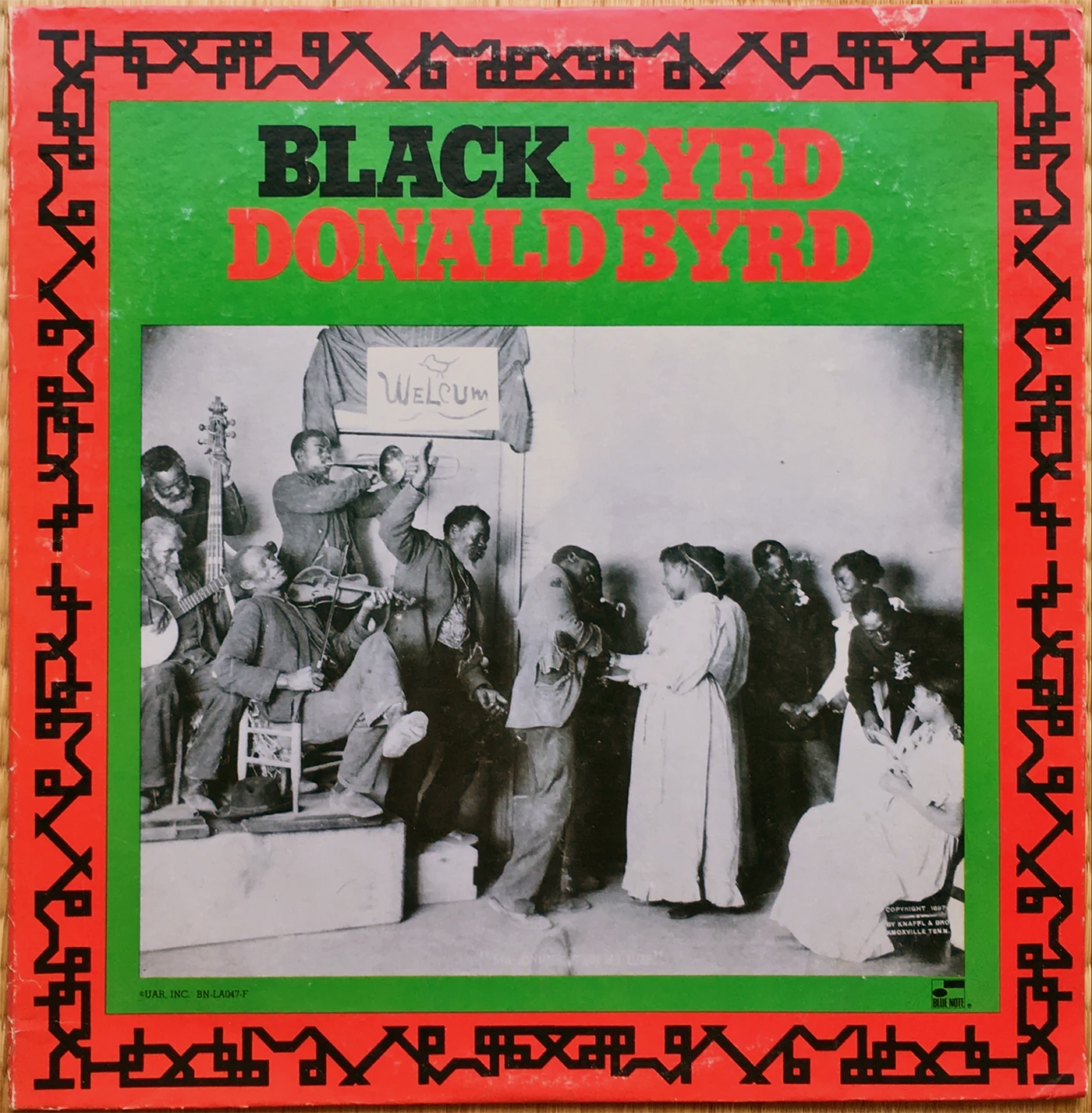
Hello and sorry about the delay in publishing the unplanned 5th installment of Listen to the Music. Rapid political, social, and cultural changes are always unsettling. Thanks for letting me vent through my “We Do Solemnly Swear” posting last week.
TJ
I absolutely love the album cover pictured above. A blend of joy, intimacy and plain old fun brought together by music. It’s power knows no bounds. This is one of the artists I used to woo my wife Deborah. The other being Keith Jarrett. If he is unfamiliar to you I highly recommend you listen to THE KOLN CONCERT... the entire album. It is actually one long composition that will send your soul aloft.
Album Cover: Donald Byrd’s Black Byrd album cover, released in 1973 by Blue Note Records. I purchased it in 1977. In the bottom right hand corner is the copyright and the notation, “Knoxville, TN 1897.” Listen here.
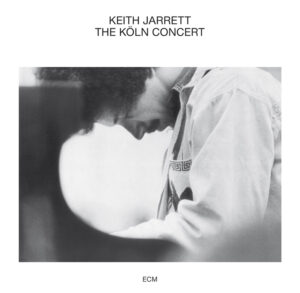
Without further ado let’s look at the dramatic expansion of nearly everything associated with the world of music, beginning where we left off in Part 3, with the 1950’s. I will then launch into what surely must be everyone’s favorite growing up decade, the 60’s. This may be more history than you bargained for but having lived through 5+ decades of amazing changes in music it can often feel like a blur. So, here is what happened while we were singing and dancing to our own beat. To keep the appearance of this article, clean and avoid being overwhelmed by facts and figures, the Musical History of the 1970’s onward will be presented “under the tab” so to speak. You can click on the colored tabs below to bring up any of the decades that may interest you. Click it again to close. Nice and tidy.
Rock-N-Roll of course pretty much defined the 1950’s and dominating popular music for much of the decade. A blend of black musical genres like rhythm and blues, Gospel, Country & Western and Pop. Do not confuse Gospel with Church Music. This is Gospel, Southern Baptist style. This is traditional church music sung in Latin. Not quite Gregorian Chant but close. My priest at Sacred Heart in Batavia, did not sound this good.
My Personal Experience with the 1950’s.
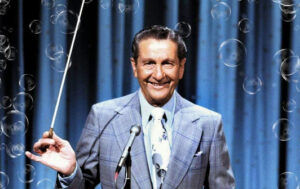 I was only in the single digits growing up in the 50’s, so, most of my music was dictated by my parents. Most likely, I was exposed to a blend of their “golden oldies” like Glen Miller and Duke Ellington along with burgeoning stars like Frank Sinatra and Nat King Cole. I do remember watching Lawrence Welk with the family on Sunday evenings. Welk is synonymous with Polka Music so as the son of Polish and Lithuanian immigrants I had to love like tolerate polka. I did like the bubbles.
I was only in the single digits growing up in the 50’s, so, most of my music was dictated by my parents. Most likely, I was exposed to a blend of their “golden oldies” like Glen Miller and Duke Ellington along with burgeoning stars like Frank Sinatra and Nat King Cole. I do remember watching Lawrence Welk with the family on Sunday evenings. Welk is synonymous with Polka Music so as the son of Polish and Lithuanian immigrants I had to love like tolerate polka. I did like the bubbles.
I do not remember my parents ever playing rock-n-roll but none the less, songs like “You ain’t nothin but a hound dog” or Bill Haley and the Comets’- “Rock Around The Clock”, made it into my small world. Probably via the radio. For some reason, though I was only 8, I remember Elvis being drafted.
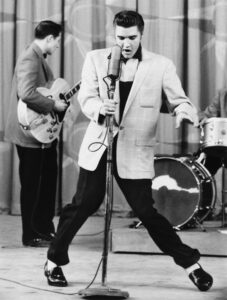
The 1950s were a transformative decade in music, setting the stage for many modern genres. The dominant musical styles of the era included:
One big way in which we were all expose to music was through the Movies and of course, television. The use of music in these mediums was much different then today.
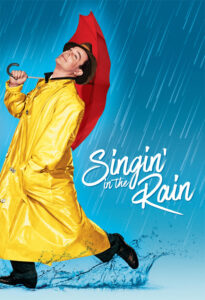
Movies
TV Shows
Theme Songs and Opening Scores: TV shows in the 1950s had theme songs, but they were usually short instrumental pieces (e.g., I Love Lucy, The Twilight Zone). These themes became iconic but were not as elaborate as modern TV theme songs. With one exception of course: “” Mr. Trouble never hangs around, when he hears this mighty sound. Here I come to save the day, that means that Mighty mouse is on his way.”
Comparison to Today
Summary
The 1950s were a pivotal decade that saw the birth of rock and roll, the rise of R&B, the popularity of crooners, and the evolution of jazz and country. By the end of the decade, youth culture and rock and roll were reshaping the music industry, setting the stage for the explosive changes of the 1960s.
One if by Land, two if by sea, three if by air? How would Paul Revere alert us to the “British Invasion” in the 1960’s?
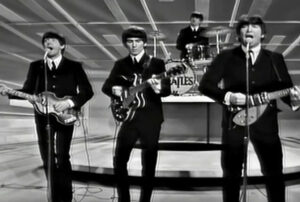
The British Invasion in music began in the early 1960s, when British rock and pop bands gained massive popularity in the United States and influenced American music and culture. The movement was sparked by a combination of musical innovation, changing social trends, and the rise of television.
Here’s How:
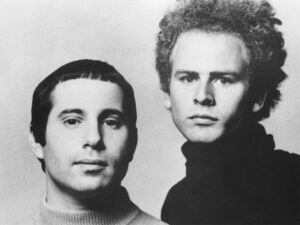
By the late 1960s, the dominance of British bands waned as American artists like Jimi Hendrix, The Doors, and Creedence Clearwater Revival emerged. However, the British Invasion permanently shaped rock and pop music, influencing generations of musicians worldwide.
Here is a chart containing some of the key players in popular music during and after the British Invasion. America accepted the challenge, rose to the opportunity, then just kept on going.
The Brits | USA | ||
The Beatles | Spencer Davis Group | The Beach Boys | Crosby, Stills, Nash & Young |
The Rolling Stones | Traffic | The Byrds | The Lovin Spoonful |
The Who | Fleetwood Mac | The Doors | Paul Revere & The Raiders |
The Kinks | The Association | Credence Clearwater Revival (CCR) | Sly and the Family Stone |
The Yardbirds | Led Zeppelin | Jefferson Airplane | Iron Butterfly |
Cream | The Dave Clark Five | The Grateful Dead | The Young Rascals |
Pink Floyd | Solo Performers | The Band | Steppenwolf |
The Animals | Donovan | Simon & Garfunkel | Canned Heat |
The Zombies | Dusty Springfield | Buffalo Springfield | The Mamas and Papas |
Manfred Mann | Tom Jones | Janis Joplin (Big Brother and the Holding Company) | The Temptations |
The Moody Blues | Engelbert Humperdinck | Jimmy Hendrix | Frank Zappa and the Mothers of Invention |
Procol Harum | Marianne Faithfull | Santana | Booker T & the M.G.’s |
Herman’s Hermits | Petula Clark | The Allman Brothers | The Monkees |
| Solo Performers | ||
| Joan Baez | Linda Ronstadt | |
Bob Dylan | Peter, Paul & Mary | ||
Aretha Franklin | Judy Collins | ||
Elvis Presley | Arlo Guthrie | ||
James Brown | Glen Cambell | ||
Cher | Kris Kristofferson | ||
Marvin Gaye | James Taylor | ||
Ray Charles | Carole King | ||
Brenda Lee | Otis Redding | ||
Roy Orbison | Patsy Cline | ||
Johnny Cash | Etta James | ||
Sam Cooke | Dolly Parton | ||
The Brits | |
The Beatles | Spencer Davis Group |
The Rolling Stones | Traffic |
The Who | Fleetwood Mac |
The Kinks | The Association |
The Yardbirds | Led Zeppelin |
Cream | The Dave Clark Five |
Pink Floyd | Solo Performers |
The Animals | Donovan |
The Zombies | Dusty Springfield |
Manfred Mann | Tom Jones |
The Moody Blues | Engelbert Humperdinck |
Procol Harum | Marianne Faithfull |
Herman’s Hermits | Petula Clark |
.
USA | |
The Beach Boys | Crosby, Stills, Nash & Young |
The Byrds | The Lovin Spoonful |
The Doors | Paul Revere & The Raiders |
Credence Clearwater Revival (CCR) | Sly and the Family Stone |
Jefferson Airplane | Iron Butterfly |
The Grateful Dead | The Young Rascals |
The Band | Steppenwolf |
Simon & Garfunkel | Canned Heat |
Buffalo Springfield | The Mamas and Papas |
Janis Joplin (Big Brother and the Holding Company) | The Temptations |
Jimmy Hendrix | Frank Zappa and the Mothers of Invention |
Santana | Booker T & the M.G.’s |
The Allman Brothers | The Monkees |
Solo Performers | |
Joan Baez | Linda Ronstadt |
Bob Dylan | Peter, Paul & Mary |
Aretha Franklin | Judy Collins |
Elvis Presley | Arlo Guthrie |
James Brown | Glen Cambell |
Cher | Kris Kristofferson |
Marvin Gaye | James Taylor |
Ray Charles | Carole King |
Brenda Lee | Otis Redding |
Roy Orbison | Patsy Cline |
Johnny Cash | Etta James |
Sam Cooke | Dolly Parton |
Dominant Musical Styles of the 1970s:
The 1970s were a diverse decade in music, marked by the continuation of 1960s styles and the emergence of new genres. Key styles included:
Dominant Musical Styles of the 1980s:
The 1980s saw technological advancements, synthesizers, and MTV shaping music trends:
Both decades left a lasting impact on modern music, with the 1970s refining rock and pop and the 1980s introducing digital innovation and global pop dominance.
Dominant Musical Styles of the 1990s:
The 1990s were a decade of diversity and transition, with genres evolving and new styles emerging.
Dominant Musical Styles of the 2000s:
The 2000s were shaped by digital media, streaming, and the globalization of music.
Both the ’90s and 2000s saw significant shifts, with the former marking the rise of alternative rock and hip-hop and the latter seeing digital technology redefine how music was consumed and created.
Dominant Musical Styles of the 2010s:
The 2010s were defined by digital streaming, genre blending, and the rise of social media-driven artists.
Dominant Musical Styles of 2020–2025 (So Far):
The 2020s (up to 2025) have continued the trends of the late 2010s while introducing new innovations and shifts.
The 2020s have been defined by digital innovation, social media influence, and an increasingly globalized music scene, with no single dominant genre but rather a mix of everything.

Today, most music is consumed through digital streaming services, with platforms like Spotify, Apple Music, YouTube, and Amazon Music dominating the industry. Here’s a breakdown of how music is consumed in 2025:
Key Trends
Streaming, social media, and personalization are the defining forces in how music is consumed today.
When I was a teenager listening to music was limited to but a few formats initially but over the course of a decade or so it expanded greatly. Here are some of the musical formats that allowed us to play and enjoy music:
Became the standard for audio master recording in the 1950s, leading to the development of multi-track tape recording and hi-fi stereo recordings.
Developed in the 1950s and widely used by professionals, artists, and consumers in the 1960s, 1970s, and 1980s.
Became more common in the 1970s due to their ease of use, space-saving, and ability to be used in cars.
Audio Cassettes 1969
Then came digital recording and MP3…Napster. The MP3 audio file format was initially released on December 6, 1991. However, it wasn’t until 1998 that the first commercial MP3 players became available.
The compact disc (CD) was also developed in the late 1970s by Philips and Sony. The first commercially available CD player, the CD100, was released by Philips in 1982. High Def CD-1986.
Digital music became a full-fledged revolution with the launch of iTunes in 2001 by Apple. The iPod was released later that same year, and the classic iPod with a 160 GB capacity was available by 2007.
Me: I had a Sony Walkman until I lost it. I also had a Sony 400 disc CD player which of course eventually broke. It was discontinued so I could not get a new one. So now the discs are in a big box. I really must do something about that. At least an album like I have for all my DVD’s and Blue Ray discs. They were once also in a Sony dvd player that held I believe 300 DVDs. Yes, it broke too. I still have a Sony Head set from like 20 years ago with a 20-foot cable so I can listen to TV in the basement and not disturb others. The foam padding has been pealing for years so every time I use them my ears are coated with residue. A dead giveaway.
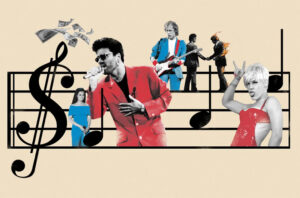 Here is a brief overview of the Music Industries annual sales figures Globaly as well as for the USA. As you will see the entire world’s annual sales volume of music sold or procurred is a little over $45 billion. If you add to it the next largest entertainment sector, cinema with annual sales of $33 billion you are at $78 billion. Throw in some other music related revenue like musical equipment sales, video game music royalties and merchandise branding you may hit $100 billion or so in annual sales…world wide. At first I thought this figure was faily small given musics’ reach and all. Then I thought I guess $100 billion is pretty good. Nearly the same as AT&T but only half of Costco. Oh well. Perhaps it’s the way the term billions has been tossed around recently.
Here is a brief overview of the Music Industries annual sales figures Globaly as well as for the USA. As you will see the entire world’s annual sales volume of music sold or procurred is a little over $45 billion. If you add to it the next largest entertainment sector, cinema with annual sales of $33 billion you are at $78 billion. Throw in some other music related revenue like musical equipment sales, video game music royalties and merchandise branding you may hit $100 billion or so in annual sales…world wide. At first I thought this figure was faily small given musics’ reach and all. Then I thought I guess $100 billion is pretty good. Nearly the same as AT&T but only half of Costco. Oh well. Perhaps it’s the way the term billions has been tossed around recently.
MUSIC INDUSTRY SALES- USA | |||||||||||||||||||||||||||||||||||
| 2023 Sales | Revenue | Market Share | |||||||||||||||||||||||||||||||||
| Recorded Music | |||||||||||||||||||||||||||||||||||
| Streaming Services | $13.3 Billion | 88% | |||||||||||||||||||||||||||||||||
| Sound Exchange Royalties | $1.3 Billion | 9% | |||||||||||||||||||||||||||||||||
| Digital Downloads | $434 Million | 3% | |||||||||||||||||||||||||||||||||
| Physical Formats | |||||||||||||||||||||||||||||||||||
| Vinyl Records | $1.4 Billion | 74% | |||||||||||||||||||||||||||||||||
| CDs | $483 Million | 26% | |||||||||||||||||||||||||||||||||
| Misc. | $183 Million | ||||||||||||||||||||||||||||||||||
| TOTAL | $17.1 Billion | an 8% increase over 2022 | |||||||||||||||||||||||||||||||||
Summary: Streaming continues to dominate the music industry (ex. Spotify, Apple Music etc.). Vinyl records have seen a resurgence, outselling CDs for a second consecutive year. CD sales continue to decline as do Digital Downloads dropping 12% from 2022.
| |||||||||||||||||||||||||||||||||||
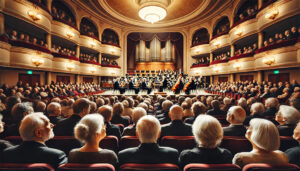 Sitting in the Boulder Presbyterian Church this past Christmas enjoying Canticle Choir music, I noticed that 90% plus of the audience had white hair. Which is to say they are my age…old. Afterwords, I thought about Classical Music, envisioning the New York Philharmonic. They too are primarily supported by a much older population. So, I thought what happens when we are gone. Will Classical Music survive? Will anyone pay to see Canticle Music performances?
Sitting in the Boulder Presbyterian Church this past Christmas enjoying Canticle Choir music, I noticed that 90% plus of the audience had white hair. Which is to say they are my age…old. Afterwords, I thought about Classical Music, envisioning the New York Philharmonic. They too are primarily supported by a much older population. So, I thought what happens when we are gone. Will Classical Music survive? Will anyone pay to see Canticle Music performances?
At first, I panicked believing the worst. I then settled into sadness resigned to accepting the worst- the end of these two forms of music. Two of the oldest, most enduring reflections of life on earth. Alas. I then decided to ask ChatGPT what she thought. Here is a summary:
The prognosis for genres like classical music, sacred/canticle music, jazz, and traditional pop—which are more frequently listened to by older Americans—is mixed. While these genres are not as dominant in mainstream music, they continue to have dedicated audiences and are adapting in the following ways:
Final Prognosis
While traditional genres are not driving mainstream music trends, they remain sustained by loyal audiences, digital streaming, live concerts, and educational outreach. The biggest challenge is ensuring younger generations continue to engage with these styles, either through reimagined compositions, film and gaming influences, or crossover collaborations with modern artists.
So, as always the future of music along with that of all mankind is in the hands of our children. Imagine that?
Yet, it is pretty easy to take music for granted. Especially, today. With over 100 million plus songs on either Spotify, Apple or Amazon Music every piece of music ever written is only a click or two away. We are also able to login to YouTube and watch a video of our favorite artist, any time of day or night. Or watch an entire concert. Perhaps the comfort of this knowledge is enough. Meanwhile, back in the day our options were way more limited. There was the radio, LP’s (vinyl), Single 45 rpm’s, local garage bands and depending your residence, bars, nightclubs and occasional concerts. Patience was required as we awaited the next album or simply news about what transpired within the music industry. With less we were probably more appreciative of what we did have and took nothing for granted.
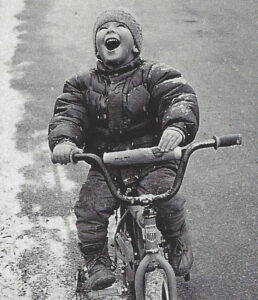
If your anything like me, you probably have an on again, off again relationship with music. Which is not to say you try to avoid live concerts, put on a CD or stream a carefully curated playlist. Rather, life often gets in the way as you help raise a family or build a business. I get it. Music, or the conscious awareness of it gets placed on the back burner. I am happy to say that music is back in my life, perhaps stronger and more intense than ever. I play some kind of music every day. Perhaps, it’s age or testosterone levels but the intensity of the emotions I feel seem more elevated that at any time in my life. This happens regularly. I teared up during the movie Mamma Mia for God’s sake. Listening to the National Anthem gets to me. I feel more alive and connected to life and I am loving it.
At times I feel like that little boy on the bike…. Nothing except my wife of course make me as happy than the memories associated with music or memories enhanced with music.
Thanks for sticking it out,
TJ

I left my home in the small Western New York city of Batavia in March 1977 vowing never to shovel snow again. Never say never. Settling for 38 years in what was for me the "promised land" of Santa Barbara, California. I married, helped raise a family, started a business, traveled and live a wonderful life. We spent the last 10 years of our west coast journey in the small, quiet, picturesque town of Ojai. My oldest friends call me TJ.
My wife Deborah and I moved to Colorado in 2015 to be near our daughter, her husband and 2 growing grand-boys. Add 2 bulldogs (French & English) to the mix and our hands and hearts are full. We all reside in Niwot, a small quaint town 15 minutes north of Boulder. The mighty Rocky Mountains are at our doorstep.
I am a man, son, brother, cousin, friend, husband, father, uncle, grand father, in-law and mostly retired Coloradan. You can read more about me on the About Page. If you are curious about my professional life you can visit my Career at Venture Horizon.
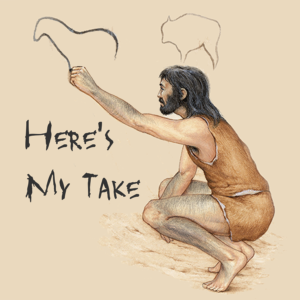
Your information is secure and private. You can cancel at any time.